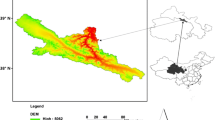Abstract
Decision tree analysis was used to predict the distribution of forest communities in an area on the south coast of New South Wales, Australia. The analysis was carried out using a geographical information system environmental data base of those topographic and geological variables thought to influence the distribution of vegetation and derived from cartographic sources. The resulting maps of forest communities are of a resolution sufficient to delimit individual forest stands and contain much ecological information.
Similar content being viewed by others
Literature Cited
Austin, M. P. 1985. Continuum concept, ordination methods, and niche theory.Annual Reviews of Ecology and Systematics 16:39–61.
Austin, M. P., R. B. Cunningham, and P. M. Fleming. 1984. New approaches to direct gradient analysis using environmental scalars and statistical curve-fitting procedures.Vegetatio 55:11–27.
Berry, J. K. 1987. A mathematical structure for analyzing maps.Environmental Management 11(3):317–325.
Breiman, L., J. H. Friedman, R. A. Olshen, and C. J. Stone. 1984. Classification and regression trees. Wadsworth, Belmont, California.
CMA. 1982. Topographic map 1:25000 KIOLOA 8926-I-N, 3rd ed. Central Mapping Authority. Bathurst, NSW.
Cocks, K. D., and I. A. Baird. 1990. The role of geographic information systems in the collection, extrapolation and use of survey data.In C. Margill (ed.), Workshop on cost effective survey methods for nature conservation. Australian Environment Council, Sydney.
Congalton, R. G. 1988. A comparison of sampling schemes used in generating error matrices for assessing the accuracy of map generated from remotely sensed data.Photogrammetric Engineering and Remote Sensing 54(5):593–600.
Davey, S. M. 1989. The environmental relationships of arboreal marsupials in a eucalypt forest: a basis for Australian wildlife management. PhD thesis. Forestry Department, Australian National University, Canberra, Australia.
Davey, S. M., and T. W. Norton. 1989. State forests in Australia and their role in wildlife conservation.In D. A. Saunders, A. J. M. Hopkins, and R. A. How (eds.), Australian ecosystems: 200 years of utilisation, degradation and reconstruction. Surrey Beatty and Sons and the Australian Ecological Society, Sydney (in press).
Davey, S. M., and J. J. Russel-Smith. 1984. A case study in collecting resource information for forest managers. Pages 263–274in K. Myers, C. R. Margules, and I. Musto (eds.), Survey methods for nature conservation, Vol. 2. CSIRO, Canberra.
Galloway, R. W. 1976. Geology. Pages 17–19 M. P. Austin and K. D. Cocks (eds.), Land use on the south coast of New South Wales, Vol 2, Bio-physical background studies. CSIRO, Canberra, Australia.
Gostin, V. A. 1969. Stratigraphy and sedimentology of the lower Permian sequence in the Durras-Ulladulla area Sydney Basin, N.S.W. PhD thesis. Department of Geology, Australian National University, Canberra, Australia.
Hutchinson, M. F. 1989. A new method for gridding elevation and streamline data with automatic removal of spurious pits.Journal of Hydrology 106:211–232.
Kuchler, A. W. 1988. The classification of vegetation. Pages 67–80in A. W. Kuchler and I. S. Zonneveld (eds.), Vegetation mapping. Kluwer Academic Publishers, Dordrect.
McColl, J. G. 1969. Soil-plant relationships in a eucalyptus forest on the south coast of New South Wales.Ecology 50:354–362.
McColl, J. G., and F. R. Humphreys. 1967. Relationships between some nutritional factors and the distributions ofEucalyptus gummifera andEucalyptus maculata.Ecology 48:766–771.
McCutchin, G. R. 1978. Species distribution and environmental relationships in a south coast forest. Honors thesis. Australian National University, Canberra, Australia.
Moore, D. M. 1988. SIMPLE: an analytical system for spatial data. BSc honors thesis. Geography Department, Australian National University, Canberra, Australia.
Quinlan, J. R. 1986. Induction of decision trees.Machine Learning 1:81–106.
Rauscher, T. M., and T. M. Cooney. 1986. Using expert system technology in a forestry application: the CHMAPS experience.Journal of Forestry 843:14–17.
Skidmore, A. K. 1989a. An expert system classifies eucalypt forest types using thematic mapper data and a digital terrain model.Photogrammetric Engineering and Remote Sensing 54(10):1415–1421.
Skidmore, A. K. 1989b. Unsupervised training area selection in forests using a non-parametric distance measure and spatial information.International Journal of Remote Sensing 10(1):133–146.
Tomlin, C. D. 1983. Digital cartographic modelling techniques in environmental planning. Unpublished PhD dissertation. Yale University, New Haven, Connecticut.
Turner, B. J., and D. M. Moore. 1987. Can SPOT help the forest manager? Fourth Australian Remote Sensing Conference. pp. 776–787.
Turner, J., J. Kelly, and L. A. Newman. 1978. Soil nutrientvegetation relationships in the Eden area. N.S.W. II. vegetation-soil associations.Australian Journal of Forestry 41:208–223.
Walker, P. A., and D. M. Moore. 1988. SIMPLE—an inductive modelling tool for spatially distributed data.International Journal of Geographical Information Systems 2:1.
Williams, G. J. 1987. Some experiments in decision tree induction.The Australian Computer Journal 19(2):84–91.
Whittaker, R. H. (ed.). 1978. Ordination of plant communities. Handbook of vegetation science, No 5. Junk, The Hague.
Zonneveld, I. S. 1988. Survey approaches. Pages 203–209in A. W. Kuchler and I. S. Zonneveld (eds.), Vegetation mapping. Kluwer Academic Publishers, Dordrect.
Author information
Authors and Affiliations
Rights and permissions
About this article
Cite this article
Moore, D.M., Lees, B.G. & Davey, S.M. A new method for predicting vegetation distributions using decision tree analysis in a geographic information system. Environmental Management 15, 59–71 (1991). https://doi.org/10.1007/BF02393838
Issue Date:
DOI: https://doi.org/10.1007/BF02393838




